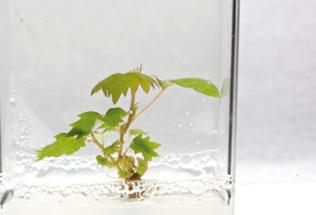
1 minute read
Plants for the future

Fire Blight In Rosaceae
Fire blight, caused by the bacterial pathogen Erwinia amylovora, is the most destructive bacterial disease of rosaceous plants (apples and pears), and in recent years this disease has caused serious economic losses around the world. Although a considerable amount is known about the pathogen, the genetic basis of resistance and susceptibility in apple is still relatively unknown. The aim of our work is to understand the mechanisms of interaction between Erwinia and apple, pear and strawberry plants. To achieve this, we are currently using high throughput RNA sequencing to carry out a transcriptomic analysis of resistant and susceptible plants inoculated with wild type and mutant strains of E.amylovora
[Laura
Righetti, Mickael Malnoy]
Apple Proliferation Resistant Rootstocks
36 genotypes resistant to Apple Proliferation were selected from a breeding programme with the wild species M. sieboldii, donor of the resistance trait. Strategies such as in vitro screening tests, molecular marker development and screenhouse experiments allow for more rapid selection of resistant plants in the field. The 36 genotypes passed all tests and further transmission trials with latent viruses are currently under way to verify the response of these plants to viruses as well. Field experiments have also been set up to evaluate the agronomic value of these genotypes as alternatives to commercial rootstocks.
[Claudia
Bisognin]
THE MEANING OF ʻRECOMBINANT DNAʼ
Annual Meeting Of The European Project Grapegen 06
Research institutes and grapevine collections from 17 countries in Europe, the Caucasus and North Africa have been working together since 2007 to characterise and manage grapevine genetic resources. The ultimate objective of the project is to develop an optimised conservation scheme for the Vitis germplasm, involving ex-situ, cryo- and on-farm conservation, to ensure resources are permanently maintained, easily accessible and field-tested in a relevant agricultural context. This network of resources will also provide plant material for use in biotechnological, genomic and breeding research.
[Maria
Stella Grando, Flavia Maia Moreira]
Lucia Martinelliʼs explanation of the meaning of ʻRecombinant DNAʼ with its scientific significance and implications for society, is one of the many entries in the Encyclopedia of Science and Technology Communication (2010). Edited by S. Hornig Priest and published by Sage it is the first encyclopedia devoted to scientific communicators. Each entry contains theoretical material and background on recent controversies as well as key institutional actors and sources, providing useful information for scientific communicators.
[Lucia Martinelli]




